 On June 5th, 2015, the 20th Dead Duck Day attracted a crowd of about 50 people. They gathered at the spot where it all began, right below the all glass facade of the Natural History Museum Rotterdam. At exactly 17:55h Kees Moeliker, in company of the stuffed duck (NMR 9989-00232), welcomed everybody. As all people more or less understood Dutch, he proceeded in that language. After a minute of silence on behalf of the duck and the b
On June 5th, 2015, the 20th Dead Duck Day attracted a crowd of about 50 people. They gathered at the spot where it all began, right below the all glass facade of the Natural History Museum Rotterdam. At exactly 17:55h Kees Moeliker, in company of the stuffed duck (NMR 9989-00232), welcomed everybody. As all people more or less understood Dutch, he proceeded in that language. After a minute of silence on behalf of the duck and the b illions of other birds that have died in collision with glas building, Kees Moeliker payed a tribute to the recently deceased Robert W. Dickerman, the
illions of other birds that have died in collision with glas building, Kees Moeliker payed a tribute to the recently deceased Robert W. Dickerman, the
ornithologist who first described (homosexual) necrophilia in a ground squirrel (in 1960) and coined the term ‘Davian Behavior’ for that – distinguishing it from necrophiliac behavior in humans. Bob Dickerman should be remembered as the man who gave necrophilia a good name.

Professor Menno Schilthuizen.
Then professor Menno Schilthuizen read the pages from is recent book ‘Nature’s Nether Regions‘ that are devoted to ‘the first case of homosexual necrophilia in de mallard’ – the reason of this annual gathering. He also presented his insights in the functional anatomy of duck genitals. Then there was an equally joyful announcement: the performance of ‘The Homosexual Necrophiliac Duck Opera’ at the Tête à Tête Opera Festival in Londen, 8/9 August 2015.
A thunderstorm, the first ever experienced in 20 years of Dead Duck Day, forced the crowd to take shelter in the Natural History Museum where ceremony proceeded smoothly, with the presentation of the new Dead Duck Day logo and the accompanying fashion line, designed by Mark Prinsen.
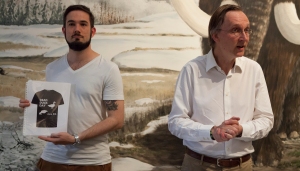
Mark Prinsen (left) shows the DDD fashion line.
This years necrophilia news originated from Azerbaijan. It concerns a free-ranging Central Asian Tortoise (Testudo horsfieldii) that tried to mate with the smelly empty shell of a male congener. Stephen Butler witnessed this in his back yard and donated the shell to the Natural History Museum Rotterdam, where it bears catalogue number NMR 9988-00702. The carapax was shown to the audience, and so was the old shirt in which it was wrapped when the specimen reached the museum.
The special Dead Duck Day Message was written and send in by Anil Aggrawal, professor of forensic medicine, Maulana Azad Medical College, New Delhi, and foremost expert on human necrophilia. It was read aloud, by Kees Moeliker:
 Necrophilia is a behaviour which reveals its unlimited curiosities almost regularly. Kees discovered a curiosity 20 years back. About a decade later as we were studying necrophiles from around the world, we discovered that it could be classified in 10 different types, starting from most innocuous “Role players” to the most dangerous “Exclusive necrophiles”. Gradually as we studied other paraphilias, it dawned upon us, that the very same classification could be extended to zoophiles too. Both studies were published in reputed journals. Were we on to something big? Do all paraphilic behaviors show same 10 gradations? Does a so-called “law of paraphilic equivalence” exist, which might state something to the effect that “all paraphilias are similar to one another, in as far as all of them exist on a continuum of increasing severity ranging from the most innocuous to the most dangerous?” Curiously as we studied more and more paraphilias with this objective in mind, we discovered that the law indeed was true. Most recently we have proved this in relation to even non-contact paraphilias, eg exhibitionism. For quite some time now, we had been thinking to bring together on one platform the necro-academics [my own term for scientists exploring this behavior] from around the world and publish their findings together in one book. Three academicians from around the world, including me got together a year back and were able to do exactly that. We got about 40 necro-academics from around the world and asked them to contribute their own experiences in the field of necrophilia in an anthology called ‘Understanding Necrophilia: A Global Multidisciplinary Approach’. Kees, to our honor, agreed and wrote an excellent chapter on necrophilia in the animal kingdom. I hope one day he discovers the 10 different kinds of necrophilia in the animal kingdom too, just as we have discovered it in humans. Necrophilia, thus, not only is a curious behavior, it is leading us on to new vistas in the study of paraphilic behavior.
Necrophilia is a behaviour which reveals its unlimited curiosities almost regularly. Kees discovered a curiosity 20 years back. About a decade later as we were studying necrophiles from around the world, we discovered that it could be classified in 10 different types, starting from most innocuous “Role players” to the most dangerous “Exclusive necrophiles”. Gradually as we studied other paraphilias, it dawned upon us, that the very same classification could be extended to zoophiles too. Both studies were published in reputed journals. Were we on to something big? Do all paraphilic behaviors show same 10 gradations? Does a so-called “law of paraphilic equivalence” exist, which might state something to the effect that “all paraphilias are similar to one another, in as far as all of them exist on a continuum of increasing severity ranging from the most innocuous to the most dangerous?” Curiously as we studied more and more paraphilias with this objective in mind, we discovered that the law indeed was true. Most recently we have proved this in relation to even non-contact paraphilias, eg exhibitionism. For quite some time now, we had been thinking to bring together on one platform the necro-academics [my own term for scientists exploring this behavior] from around the world and publish their findings together in one book. Three academicians from around the world, including me got together a year back and were able to do exactly that. We got about 40 necro-academics from around the world and asked them to contribute their own experiences in the field of necrophilia in an anthology called ‘Understanding Necrophilia: A Global Multidisciplinary Approach’. Kees, to our honor, agreed and wrote an excellent chapter on necrophilia in the animal kingdom. I hope one day he discovers the 10 different kinds of necrophilia in the animal kingdom too, just as we have discovered it in humans. Necrophilia, thus, not only is a curious behavior, it is leading us on to new vistas in the study of paraphilic behavior.
The 20th Dead Duck Day ended with the traditional Dead Duck Day Dinner at the famous Tai Wu Restaurant, where about 35 people enjoyed each others company and good food. [all pictures, courtesy of Anjes Geesink] 



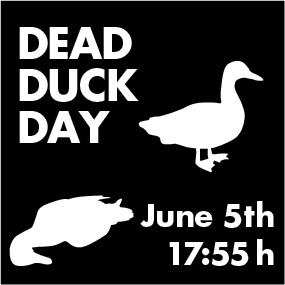

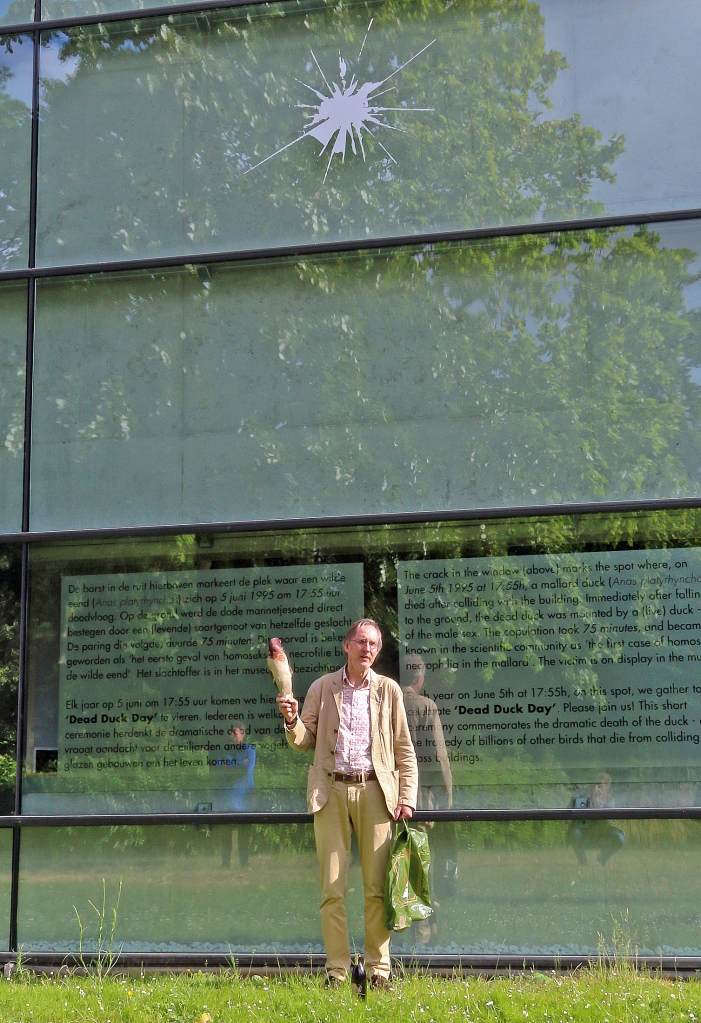
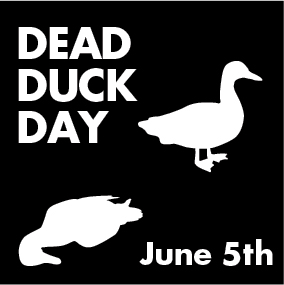
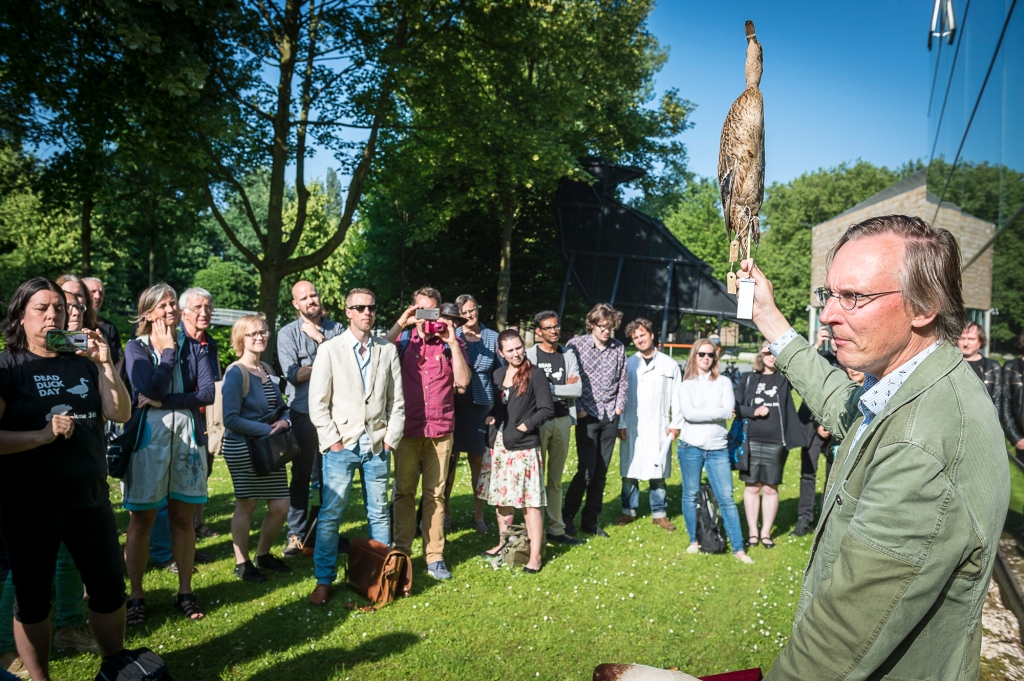






 Monday June 5th, 2017 is the 22nd edition of
Monday June 5th, 2017 is the 22nd edition of  The special ‘Dead Duck Day Message’, this year delivered in person by
The special ‘Dead Duck Day Message’, this year delivered in person by 




 On June 5th, 2015, the 20th
On June 5th, 2015, the 20th  illions of other birds that have died in collision with glas building, Kees Moeliker payed a tribute to the recently deceased
illions of other birds that have died in collision with glas building, Kees Moeliker payed a tribute to the recently deceased 

 Necrophilia is a behaviour which reveals its unlimited curiosities almost regularly. Kees discovered a curiosity 20 years back. About a decade later as we were studying necrophiles from around the world, we discovered that it could be classified in 10 different types, starting from most innocuous “Role players” to the most dangerous “Exclusive necrophiles”. Gradually as we studied other paraphilias, it dawned upon us, that the very same classification could be extended to zoophiles too. Both studies were published in reputed journals. Were we on to something big? Do all paraphilic behaviors show same 10 gradations? Does a so-called “law of paraphilic equivalence” exist, which might state something to the effect that “all paraphilias are similar to one another, in as far as all of them exist on a continuum of increasing severity ranging from the most innocuous to the most dangerous?” Curiously as we studied more and more paraphilias with this objective in mind, we discovered that the law indeed was true. Most recently we have proved this in relation to even non-contact paraphilias, eg exhibitionism. For quite some time now, we had been thinking to bring together on one platform the necro-academics [my own term for scientists exploring this behavior] from around the world and publish their findings together in one book. Three academicians from around the world, including me got together a year back and were able to do exactly that. We got about 40 necro-academics from around the world and asked them to contribute their own experiences in the field of necrophilia in an anthology called ‘Understanding Necrophilia: A Global Multidisciplinary Approach’. Kees, to our honor, agreed and wrote an excellent chapter on necrophilia in the animal kingdom. I hope one day he discovers the 10 different kinds of necrophilia in the animal kingdom too, just as we have discovered it in humans. Necrophilia, thus, not only is a curious behavior, it is leading us on to new vistas in the study of paraphilic behavior.
Necrophilia is a behaviour which reveals its unlimited curiosities almost regularly. Kees discovered a curiosity 20 years back. About a decade later as we were studying necrophiles from around the world, we discovered that it could be classified in 10 different types, starting from most innocuous “Role players” to the most dangerous “Exclusive necrophiles”. Gradually as we studied other paraphilias, it dawned upon us, that the very same classification could be extended to zoophiles too. Both studies were published in reputed journals. Were we on to something big? Do all paraphilic behaviors show same 10 gradations? Does a so-called “law of paraphilic equivalence” exist, which might state something to the effect that “all paraphilias are similar to one another, in as far as all of them exist on a continuum of increasing severity ranging from the most innocuous to the most dangerous?” Curiously as we studied more and more paraphilias with this objective in mind, we discovered that the law indeed was true. Most recently we have proved this in relation to even non-contact paraphilias, eg exhibitionism. For quite some time now, we had been thinking to bring together on one platform the necro-academics [my own term for scientists exploring this behavior] from around the world and publish their findings together in one book. Three academicians from around the world, including me got together a year back and were able to do exactly that. We got about 40 necro-academics from around the world and asked them to contribute their own experiences in the field of necrophilia in an anthology called ‘Understanding Necrophilia: A Global Multidisciplinary Approach’. Kees, to our honor, agreed and wrote an excellent chapter on necrophilia in the animal kingdom. I hope one day he discovers the 10 different kinds of necrophilia in the animal kingdom too, just as we have discovered it in humans. Necrophilia, thus, not only is a curious behavior, it is leading us on to new vistas in the study of paraphilic behavior.




You must be logged in to post a comment.